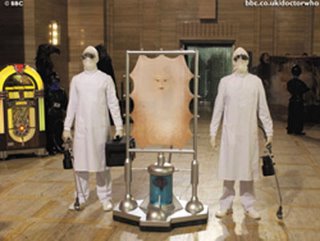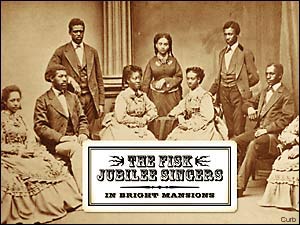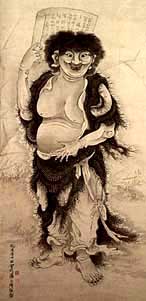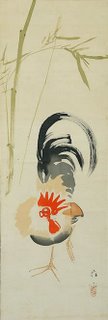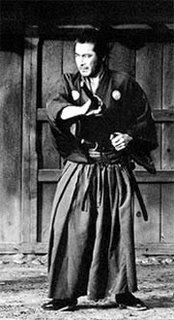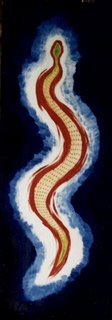 Landing on this great continent is like going to sea; they must have a compass, some friendly directing needle, or else they will uselessly err and wander for a long time, even with a fair wind.
Landing on this great continent is like going to sea; they must have a compass, some friendly directing needle, or else they will uselessly err and wander for a long time, even with a fair wind. - From
Letters from an American Farmer by J. Hector St. John de Crevecoeur (1781)
My wife is from the South and she brought us back there eventually after a stop here and a stop there. Later, in the upper Midwest we lived in a very big and a very old farm house that was loaded with bats. Here in New Hampshire our house goes back to 1790. Here we have bear.
There was a female spirit in the old Michigan house and I think that is why there were so many bats. The Dead are attracted to old houses in the country, especially if they lived there when they were alive. Death by snow plow is a common danger here in the cold parts, and the women who lived in our Michigan house was killed by a snow plow just before we moved in. In her late 70s. She was a child psychiatrist in Ann Arbor, a women from Iowa with two sisters. All three were doctors. Perhaps it was her, or Walker, who built the house in 1852, who remained behind after departure.
Generally, bats like houses built before the Civil War because they have character. And bats, the night side of birds, are attracted to the dead, because they scare people and keep them away, keeping it peaceful and quiet. You have to be careful in dealing with the spirit world and I wouldn’t advise it. Death doesn’t bother the spirits. They don’t believe in death. There is no death. It’s just moving furniture around. And with the Dead, its hard to get a grip on who they like and who they don’t and why, but we’ve always had good relations.
We have always had a terrific array of unsolicited animals living in and around our houses, more than most people, it seems. And when we arrived in Michigan one of those huge fire balls from heaven almost landed in our back yard. It was a great round ball of blue sparks that looked from earth about like a big 18-wheeler moving slowly across the moon about ten miles above the earth. I was driving at twilight in one direction down 6 Mile and it was going in the opposite direction. It was on NPR and everything.
In the South, it was snakes. Mice living in the walls at first until our cats got rid of them, then snakes. In New York City it was hawks, and my wife and I felt we knew them all personally. 20 years later I read with interest that a one-eyed hawk had given birth on a TV antenna, up by where Yoko Ono lives. Very good karma. About when Catherine was born too. We thought we might have known the hawk’s ancestors. There is a strange absence of hawks here in the northern mountains of New Hampshire.
There was also a snake in New York, the first night I arrived at my wife’s dorm room before she was my wife, being none to relaxed in fact, being conspicuously older than the students. There was a python in her room. It belonged to a friend who was away for the weekend, she said. He asked her to take care of it while he was away. Then when we left for the South, snakes were everywhere.
In our first old house in West Virginia, when only our first boy was born – a beautiful old brick farmhouse, built by German farm people in 1840 and put together with oak pegs – we were sleeping the first night when we heard a scraping sound. Like a shoe dragging by itself across the attic floor, directly above us. We sat and listened for awhile and looked at each other. Still being city people, we didn’t think that we needed to handle the situation right away and didn’t have a clue what to do. Maybe call the realtor: there are snakes in this house.
Finally, I took a flashlight and went up to the attic and I couldn’t see anything, although I heard the scrapping noise right under my feet. Then I shone the light between my feet and between the boards and I saw it moving like a slow train in the night. Like it was in a different world.
It appeared as long as a train as well. It was maybe seven feet but seemed endless. I shone the light around the room and saw maybe a dozen discarded snake skins hanging off chairs and things discarded in the attic, lightly moving with the air coming up from downstairs.
I didn’t do anything, which was the right thing to do, just went back to bed. The next day I saw them climbing up the brick in the sun, seven, eight feet long, moving slowly. They were black snakes, which are common throughout the South and they are benevolent. They eat mice, rats and other snakes, particularly copperheads, which are deadly. Farmers want to have the black snakes or rat snakes in their barn to keep the rats down. We found that they eat eggs as well but only two or three a day, which we considered salary to the snakes for doing their job eating the rats.
They are a big impressive sight, especially if you have never seen a big black seven-foot snake before. It lives in the part of your mind that has no interpretation, but is like getting past the man-made world of the mind all at once and you are back in the garden. It is like they were here first and are here always and will be here after we with our busy projects and city shoes have passed on.
I first saw one when my wife brought us South from New York for a visit. We were first starting out, and she took us to the top of one of the rolling hills in the west of Virginia, and looking out over the horizon in a state of new bliss, she said, “I can see it now . . .” waving her hand, then she screamed, “Eek!” A black snake was right under our feet crawling away from us. Six feet, maybe seven feet.
Ten years later when she was busy managing three kids and awaiting a fourth on our little farm in Tobaccoville, North Carolina, she once mildly complained that there were 47 animals in and around the house, including sheep, chickens, indoor cats, kids, outdoor cats, dogs, including one that had been kicked by a neighbor’s cow and had to live in the kitchen until it’s broken leg healed, and snakes in the barn and snakes in the cellar. By then she’d lost the eek reaction and if a copperhead had managed to get past the dogs, the cats, the blacksnakes and close up near the babies, she’d lop off its head with a shovel without a thought.
I am one of the people who are drawn to snakes. Women share something with snakes, I think, and that is why I am drawn to them. They share the same soul, I think. And Bela Lugosi offers this in the movie Ed Wood: when giving birth, the woman enters into the unconscious of the world or the Universe and after a few births going back and forth, a woman is familiar with the Unconscious and comfortable in it and at one with it. And Sun Bear has an observation. He says they share soul with the moon as well. Once a month, they complete a lunar cycle and if they all live together, like in a college dorm, their period cycles all synchronize. They share the same channel of consciousness, especially sisters. And especially at birth. They know what snakes know and share it with the moon.
Relatively speaking, a man doesn’t know about these things. It is the way of quiet understanding; the knowledge and experience of the Unconscious as it is understood in Islam and to the Zoroastrian, not the object knowledge in the mind of a white man. And when it is birthing about to happen it pulls the man in, having an affect that can’t be managed by a man’s own experience or knowledge. There is a kind of magnetism to it.
In the country, the ordinary Southern woman folk will take a string and hang it on a key and hold it in front of the pregnant woman’s stomach at about six or seven months, to tell what sex the baby is going to be. If it swings to the right it will be a boy, to the left, a girl. You can also tell what kind of a life force it will have by the velocity of the key spinning. It’s magnetism drawing the woman around the Fibonacci curve that is a black hole, down into the Universe and then out again into the world. The country people say there’s magnetism in the mountains too, which makes the lights on Brown Mountain so frequent and strange and they don’t have an explanation. Everybody in those parts believes in UFOs and don’t care what the city people think about it. They don’t even know about the string thing with a pregnant woman. Anyway, the hant woman at the farm market said the string thing doesn’t work with city people.
I was never able to put my finger on it or to understand why – maybe it is magnetism – but after a few years on the farm, people, not just twins who are famous for it, or sisters who would all be like one woman at the birth period, but everybody – high church, low church, trailer park, black and white – would all get synchronized after a few years of this kind of life among the snakes and chickens and the critters. Even for a displaced Yankee like myself, brought down from New York City. When I’d stand in my front yard thinking, “I’ve got to get that stump out one way or another,” later that day a good ole’ boy would drive up in his truck and ask if I needed any stumps removed. Or if I’d think to myself, “How am I going to get rid of those extra roosters?” an old country man with sons would appear who my wife had sold chickens to the year before and ask if I had any this year. Birth cycle, in and out, ties you all to the mountain like sewing, says the hant woman.
But after a while it got kind of ponderous and heavy, especially after the third boy was born. It was about that period – when the third was five to six months in the womb – that there got to be a burden on my mind. Had I been raised on that particular mountain and on that spot it might have been different. Also, just about then our friend Catherine. I could feel her coming.
Driving to Chapel Hill one day, I heard on a call-in radio show where you call in and ask the astrologer for advice, a man with my birth date, July 15, called and asked the woman on the radio what kind of wife he should get. Pisces, she said, early spring, or just the opposite; Scorpio, early fall. Now these are not opposites like yin and yang, she said, male and female, they are ascending and descending charges of the one force, in this case, the feminine force for the guy who called in about getting a wife. The both together represent the fullness of the force, in a united episode. My wife was Pisces, perfect for a man born under Cancer as I was, and Catherine was a Scorpio, perfect for a friend and companion. She was new in my office, the artist who would design the magazine I worked for. We would be friends and she would become a special friend of our family.
But a lot of things started happening all at once, just before we met Catherine and I found it quite disturbing and destabilizing. It started one night when the third boy was six months in the womb. I had a dream that I was walking through the woods with a group of Indians. Suddenly, we got to a clearing in the woods and in the center there was a round stone circle, like a primitive holy site. I stood around it in a circle with the Indians. Then they all put their weapons down and backed away into the forest. I was left standing by myself. I shouted for the Indians to come back, but they shook their heads no.
When I woke up I didn’t know what to do. I’d always dreamed of Indians acting as guides and felt navigating through life was a breeze, so long as I had my Indian guides. Now I was alone in a stone circle. Next night I dreamed I was alone at sea in a ship and was being tossed about by the stormy sea.
a stone circle. Next night I dreamed I was alone at sea in a ship and was being tossed about by the stormy sea.
The other unusual thing was a series of coincidences that occurred when I first encountered befriended Catherine.
I raised sheep, and was in the market for some. Tunis sheep; pretty, reddish sheep with long ears like goats – these were sheep of African stock that were well suited to the hot, dry climate of North Carolina. But they were hard to find. There were only two breeders in the state. I’d been to one that weekend, but didn’t like his stock, as they’d been crossed with Dorset and had lost their pretty faces. So I needed to find the other breeder.
That Monday morning I went to work and was introduced to Catherine, who would be my new office mate. We got into a conversation and I told her about my weekend trip to look at sheep.
“I have sheep,” she said, to my surprise.
Sure enough. I checked the breeder’s directory and there she was. Listed as the only other breeder of Tunis sheep in the state.
There was a truck thing too. I had a 20-year-old Dodge pick-up with a Custom Cab that I’d paid $800 for ten years before when I bought if from an Elvis worshiper. It was a rare beauty. Jim, my office mate, said that as long as I had that truck I was a special person. If I didn’t have that truck I’d just be a chump, down from New York City and talking louder than the other people. The Custom Cab only underwent small production in that model and I’d never seen one exactly like it in ten years. But Catherine had one exactly like it. Only mine was red and hers was blue.
After I had that dream about the stone circle I started to have great but confusing dreams. I’d always taken my Indian guides for granted and assumed they would always be by my side. Now I was alone.
My sister-in-law who has a gift for knowing what to do in situations like this, suggested I read Drawing on the Right Side of the Brain and learn to draw. She bought a variety of pencils and drawing papers. I discovered what I’d long forgotten, that I can draw. That is, I could draw as a child, but had given it up and forgotten about it as a teenager.
I was suddenly taken by the desire to draw and set up a studio in the barn. Dreams were unrelenting now and I decided to draw the pictures that appeared in the night. Some students and a few faculty became interested and so did Catherine and I often had visitors in my studio barn.
This continued for two years. The third boy was born and things were going well, not bad that is, without my Indian helpers, but I was managing, just managing, to retain balance by painting my visions in the barn. There were flaming swords and many pictures and sculptures of a strange stick man with branches growing out of his head who I often dreamed of. These dreams were so rich and intense that they made the outside world pale by comparison. When I started to draw in the barn, I noticed the sheep and chickens would all get very quiet and become passive. One night I dreamed that the strange stick man climbed out of the stone circle. Then I discovered that other people had seen these pictures in dreams as well.
At a special exhibit of old Celtic manuscripts at the college, I happened to notice a figure just like the stick man, Chernunnus, he was called. He was considered a fore-father of the Green Man, the text said. I looked further and found drawings of other things I had drawn.
I began to understand that this was an ancestral force coming to the conscious mind. It could be nothing else. But I’d about lost interest in these ancient things as a new image was compelling my drawing and painting. I felt a strong desire, a compulsion, to draw snakes.
Catherine often visited the studio and stayed with the family for supper. When she moved to a city house from the country, she asked if she could leave her chickens with us, and we agreed, so she dropped off a chicken that the children named Magisto, the Flying Chicken, and two others.
This was a very special chicken, it turned out. It was a very small bantam, pure white, more like a dove than a chicken. What was special about her was that she liked to be picked up and pet by the children like a puppy or a kitten. The children loved to play with her and Magisto would rush out to see them when they arrived home from school. Magisto could also fly – only very small chickens can fly, ours could not – and he would fly up and light on the childrens’ shoulders. Catherine’s two other chickens were giants called Dominiques, beautiful black and white spotted birds that followed Magisto everywhere she went, one on one side, one on the other, like guard dogs.
But I wasn’t elated by the birds or anything else. And I knew what had sent my soul down beneath a funk for almost two years now that I could not retrieve it from. My mother had died almost three years earlier, and if a husband flows into the wife’s soul at child birth to some unsettling degree, so too when his mother dies, maybe his soul goes with her.
When my mother died, I died, and I could not get back. And that is what sent my soul to the Celtic netherland of flaming swords and Trees with the Eyes of God. I had no idea how I would get out or how I could survive there. And on top of that my wife was heavy with what would be our fourth child and, the tests told us, our first girl.
Snakes in the night, then snakes under water and snakes rising out of the water. These were the pictures I was compelled to paint in the barn while I ignored the demands of my family. The most vivid dream was of an ancient ship maybe a thousand years old coming into port but at a subway stop filled with water. I touched the old charred hull but found it to be fresh pitch. But then I had the most pleasant dream: I dreamed that I was standing in a river – the river of life and death, I knew – when a brightly colored snake, like a coral snake, flowed down the river. Everyone was afraid of the deadly coral snake and ran away, but I was not afraid. I knew it was not a coral snake but a milk snake, a gentle snake which disguises itself as a coral snake to fool its predators. I lifted it up out of the river, held it high and joyfully played with it.
One day just before the baby was born, I was standing in the corral with the sheep, leaning on the gate, thinking. Why don’t we name the baby Catherine, I thought to myself, like our friend? Just then my wife walked out of the house and came down to talk, not knowing what I’d been thinking.
“Do you know what I’ve been thinking?” she asked.
“What?” I answered.
“Why don’t we name the baby Catherine,” she said?
I was not surprised because things like that were happening all the time now.
“Your mother’s name was Catherine,” she said, “Did you know that?”
No, I answered, she was wrong. My mother’s name was Kathleen. I ought to know my mother’s name.
“No, you’re wrong,” she said, then she relayed an astonishing story.
Before my grandfather came over from Ireland he had been married to a woman named Catherine who had died in child birth. When my grandmother gave birth to my mother she named her Catherine and that was the name put on the birth certificate. Then, coming home from the hospital she recalled her husband’s first wife had been named Catherine and didn’t want to name her daughter after her husband’s first wife. So she scratched the name Catherine off the birth certificate and wrote in Kathleen. All my life my mother had been cheated out of her true name.
“How do you know this?” I asked my wife.
“Your sister learned it at your mother’s funeral,” she said.
Catherine was the name decided on for the baby and the other Catherine, our friend, was delighted.
Then a few weeks before the baby was born Catherine came to my office to tell about a dream she had had, the first and only time we talked about her dreams. She dreamed that Magisto, the white dove chicken, was carrying the soul of my mother to baby Catherine, who was about to be born, and as soon as the baby was born, Magisto would die.
That week baby Catherine was born. Mother-in-law and sister-in-law managed the house and family while I stayed at the hospital with mother and daughter. The only nuisance that occurred was the presence of a snake that had found its way into the house, which my sister-in-law kindly asked to have removed.
Magisto disappeared the following day. We never saw the bird again. Gotten by fox, coyote or hawk most likely. And I discovered the man’s joy of having a daughter and a love that transcends life and death. The boys are wonderful and I love them too, but as I was with my father, they are colleagues. They are my friends and equals. The love between a boy and his mother and a father and his daughter is exit and entrance to the world. The ancient ship that brings out the dead and brings in the living.
Maybe it is an Irish thing. Or maybe it is the dance of all life for all who have a mother.
 There is in
There is in  poured out his vial into the air; and there came a great voice out of the temple of heaven, from the throne, saying, It is done. (Rev. 16:17)
poured out his vial into the air; and there came a great voice out of the temple of heaven, from the throne, saying, It is done. (Rev. 16:17) Bergman’s rendition of The Magic Flute is a harbinger of the age here and pending. Taking his films out of their historical periods and viewing them as an expression of the artist’s own development and sensibility, his full body of work is a shaman’s journey which traverses ages, starting with The Seventh Seal at the very end of the Christian age and ending with The Magic Flute at the beginning of a new age.
Bergman’s rendition of The Magic Flute is a harbinger of the age here and pending. Taking his films out of their historical periods and viewing them as an expression of the artist’s own development and sensibility, his full body of work is a shaman’s journey which traverses ages, starting with The Seventh Seal at the very end of the Christian age and ending with The Magic Flute at the beginning of a new age.  Perhaps none surpasses Mozart’s The Magic Flute (1791) in knowledge of the masculine principle and the feminine, yang and yin, first performed at the high end of the Renaissance as the masculine principle and the Renaissance came to dominate the Earth Mother. In Mozart’s story three warriors guard the Lord of the
Perhaps none surpasses Mozart’s The Magic Flute (1791) in knowledge of the masculine principle and the feminine, yang and yin, first performed at the high end of the Renaissance as the masculine principle and the Renaissance came to dominate the Earth Mother. In Mozart’s story three warriors guard the Lord of the  Union is a study in zodiac symbolism, a blue background representing sky and air, the masculine field of Aquarius, and 12 gold stars, the full counsel of the zodiac; the council of Sarastro and the Lords of the Temple.
Union is a study in zodiac symbolism, a blue background representing sky and air, the masculine field of Aquarius, and 12 gold stars, the full counsel of the zodiac; the council of Sarastro and the Lords of the Temple.



